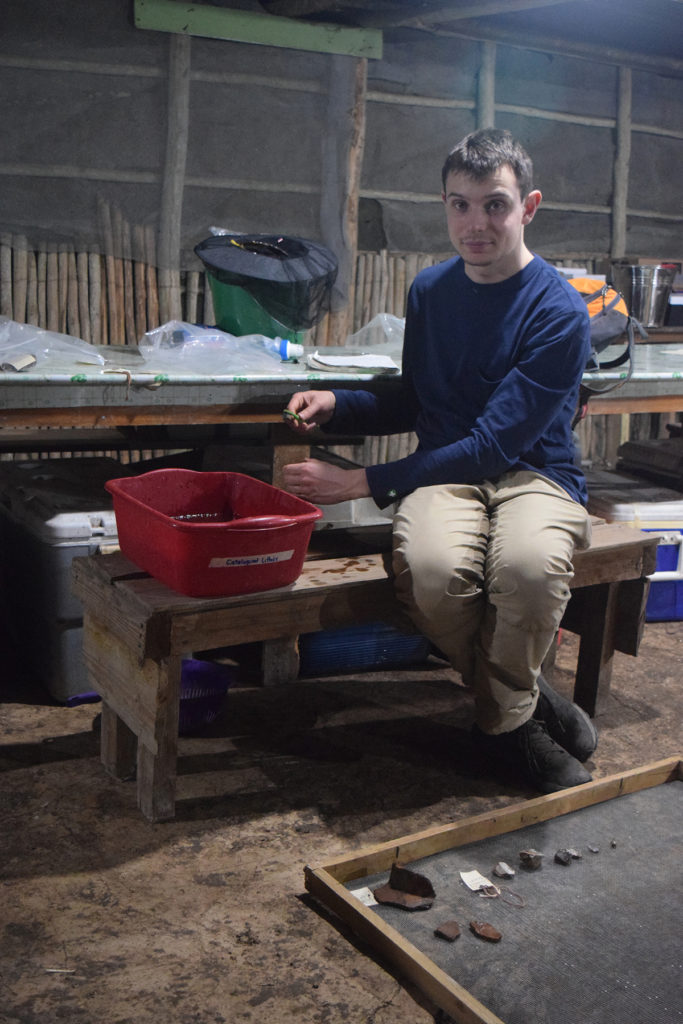Covid severely disrupted the affairs of the Caracol Archaeological Project. After a full 2020 field season, the pandemic forced us to cancel planned field seasons for both 2021 and 2022. Thus, the 37th field season of the project is finally taking place in 2023. Needless to say, almost three years of neglect relative to our camp at Caracol caused severe deterioration of some of the buildings. Thus, we funded a small crew to fix camp beginning in the second week of December. They completely re-roofed all of the thatched student housing with zinc and fixed the basic structures; the same thing occurred with the cook’s house behind the kitchen. Lab 2 was in a very sad state and had its roof fixed – as well as its tendency to lean away from the vertical. The supply shed was also completely rebuilt and re-roofed. Two new outhouses holding four toilets were also constructed and an old one was refurbished. Thus, when students and staff began to arrive in camp on January 25 (Maureen, Jordan, Shelby), everything was in order for the beginning of the field season. Little did we know that we would also have to replace the solar freezer and the generator. Three years of disuse in the tropics is harsh.
We have selected at area to the east of camp and the site epicenter for excavation. Between 2012 and 2014 we focused on excavating a series of residential groups that we referred to as the Machete neighborhood. More recent work with lidar and nearest neighbor analysis has suggested that two different neighborhoods were combined in our 2012-2014 unit and that, if we wanted to fully define the eastern portion of this neighborhood, we needed to excavate 9 more residential groups. Thus, our research design for the next two years is focused on investigating these 9 residential groups so that artifact and pattern comparisons can be made for what would constitute one completely tested neighborhood at Caracol. We started by excavating 3 residential groups that were mapped by Stephen Houston in 1985 as the farthest part of his eastern settlement transect from our project camp.
The beginning of the season was also rather complicated. I (Arlen Chase) arrived in Belize on January 20 to meet with the Institute of Archaeology and obtain the necessary permits and to also make sure that our kitchen and everything back at Caracol was properly functioning. I flew back to Ontario, California on Saturday January 28 and our son (Adrian Chase) flew into Belize from Chicago on the same day in order to help set up excavations during the first week and to orient the other students that arrived on that day with him (Sander, Luca) and were transported back to camp. Why did I have to return after a week in Belize? The other half (Diane Chase) had accepted a new position as Provost at the University of Houston that started on February 1 and I need to make sure that she got there with a vehicle and was situated with our two dogs and our bird before that date. Thus, we drove from Ontario to Houston on Sunday and Monday; we closed on a new house on Tuesday; Diane started her new job on Wednesday and I spent Wednesday, Thursday, and Friday buying a bed and a couch for the house and outfitting the kitchen for her. I flew back into Belize on Saturday February 4 and Adrian flew back to Chicago on the same day. Everything at camp was proceeding nicely.
During the week, Maureen Carpenter and Adrian had laid out excavations in the three groups mentioned above. All three groups are located on the same raised hilltop ridge and all are associated with reservoirs (which Adrian intends to test upon his return later in the season). The northernmost group is called “Astro;” the middle group is called “Houston;” and the southernmost group is called “Nasa.” Excavations began in Houston and Astro in minimally two locations in each group. In Astro, the steps of the southern building were areally excavated. A central trench was placed over the eastern building in Astro and found 3 capstones in the front part of the excavation by week’s end. In Houston a large areal excavation was placed in a vacant area on the western side of the plaza and an axial trench was placed over the eastern building. By week’s end two face caches were recovered in the plaza in front of the building. A small excavation was additionally placed over the southern wing of the eastern building. In Nasa, two excavations were placed: an areal over the step of the southern building and a small trench on the western side of the northern building. No digging occurred in Nasa during the first week of excavation (second week of the project). It should also be noted that on Wednesday the Institute of Archaeology held a barbeque retreat at Caracol during lunch and graciously cooked chicken for our group while Angie made refried beans and tortillas for their group.
All in all, a successful start for the 2023 field season.









So exciting!!!!
Please get a message to Mo that Karen got in touch with Jim and the meds she needs will be UPSd to Adrian to be delivered to her when he gets back to Belize. Thanks.
I enjoyed this first blog.